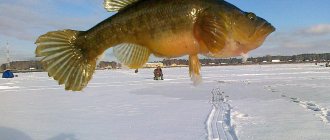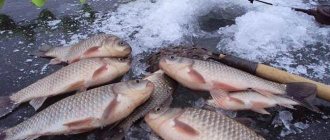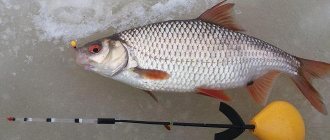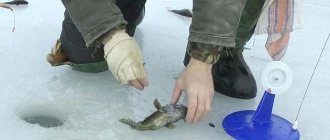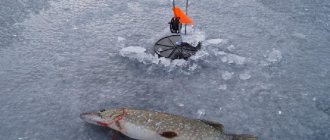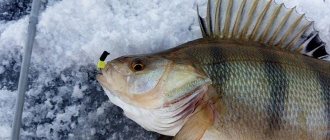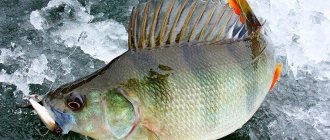Rotan behavior in winter
Throughout the winter period, the behavior of this fish changes greatly.
After the first ice appears, its parking areas remain the same as in the summer. Its habitats in water bodies are coastal zones with depths of up to 1 meter.
Somewhere in the middle of winter, it moves away from the shore to depth, since in shallow water the aquatic vegetation dies off completely. During this period, he prefers depths of 1.5 meters or more. Moreover, it can be found both in areas with a flat bottom and on riffles.
In the dead of winter, it becomes inert and cautious, like any other fish. Rotan loves to populate reservoirs with vigorous aquatic vegetation, which dies off in winter and the oxygen balance in the reservoirs is disturbed. Therefore, rotan endures wintering hard, like all fish.
How to make a jig on a rotan
Often professionals are not satisfied with the gear sold ready-made in fishing stores, so they make jigs with their own hands. The process of assembling the tackle is amusing and short-lived, and a jig made “for yourself” can bring a good catch.
The kit for making jigs depends on the type of tackle. When assembling, many people resort to soldering, forging or casting, which are difficult to do at home. A popular and reliable method of making jigs for large fish is sawing. The main task is to make a tackle that would actively play in the water column when guiding, attracting a predator.
To make a large jig you will need:
- cone-shaped or pear-shaped sinker weighing 2-3 g;
- several multi-colored beads;
- large hook with a long shank;
- thin flexible wire;
- pliers;
- bright paint;
- file or rasp;
- vice;
- hacksaw for metal.
Making homemade gear using the sawing method is not difficult if you strictly follow the algorithm of actions. To begin, secure the sinker in a vice so that it is convenient to start sawing. Use a hacksaw to make a longitudinal cut of the sinker: it is important not to cut it all the way, so that the cone does not break into two parts, leave a few millimeters.
We string 3-4 multi-colored beads onto a large jig hook with a long shank. It is important to choose beads whose holes will correspond to the thickness of the shank - they should not move freely along the hook, but be strung elastically and tightly. If desired, you can secure the beads with a cambric made from a dropper tube.
The wire must be folded in half and twisted using pliers so that you get a thin helical rod with a small eye for attaching to the fishing line. On the opposite side of the rod, you need to cut one “tail” of the wire, and string a hook on the second, bending the material so that a small eye is formed, as in the upper part.
Insert the rod into the sawn sinker so that the eye is on top and the hook is on the bottom. In this case, the bent part of the wire on which the forend is fixed must be inside the sinker in order to form a reliable ring when compressed.
All that remains is to squeeze the sinker well to tightly fix the wire rod inside the cone. After this, carefully apply paint to the sinker to give the tackle a bright color.
Fishing with a jig is a favorite, but not the only way to lure rotan. Winter fishing for rotan, about which the Internet is filled with video reports and reviews, can also be fruitful when fishing with a spoon.
Spinner with meat
When catching rotan with a spoon, fishermen often experiment with bait. Therefore, when winter fishing, each fisherman has several pieces of meat in stock, including the meat of the rotan itself. This species is characterized by cannibalism. In addition, small pieces of beef are the predator’s favorite bait. In combination with a bright spoon, they will attract the attention of fish even in muddy water and from a long distance.
The best baits include small pieces of chicken meat with skin, cut into elongated triangles. The skin quickly softens in water, becoming more elastic. When inserting a spinner, pieces of skin imitate as accurately as possible the behavior of rotan prey in the water, attracting it with color and smell. Professionals note that when fishing with chicken skin in combination with a spinner, bites follow much more often than when fishing with meat.
Fishermen are interested in the possibility of a wide selection of jigs and different types of bait for catching winter predators without compromising the catch. Most often in winter, rotan is especially voracious and unpretentious. This allows you to hone your fishing skills and tactics of working with a particular jig and, having received visual statistics, choose the best fishing method.
Finding a place to fish on a pond turns the process into a “hunt.” The reaction of rotan to different gear in winter depends on many things: illumination, atmospheric pressure, habitat and even on the period. These features fuel the excitement and force fishermen to use their entire arsenal of gear, apply their knowledge and skills to get a good catch.
What gear and equipment to choose for catching rotan in winter
Rotan can be caught with any tackle using any fishing rod. At this time, the bait is attacked by small specimens of it, which can be caught with the thinnest tackle. Unlike other types of fish that are alarmed by thick fishing lines, rotan is not afraid of thick fishing lines and can be safely caught on fishing line with a diameter of 0.2 mm.
Every fisherman knows how difficult it is to work in the cold with a very thin fishing line, and therefore using such a fishing line will make the fisherman’s task somewhat easier. As a fishing rod, you can use a winter fishing rod of the “telephone” or “balalaika” type. The optimal diameter of the fishing line is 0.08-0.16 mm. A thinner line is chosen for catching rotan in the dead of winter, and a thicker line is used for catching it on the first and last ice.
Using jig tackle
Some fishermen do not know what gear should be used to catch rotan in winter. Gear for fishing “firebrands” can be called quite rough. The most catchy gear is jig tackle, which consists of the following elements:
- winter fishing rod of any type,
- a hard nod,
- volumetric jig,
- fishing line with a thickness of 0.14−0.16 mm.
Since rotan, as a rule, lives in reservoirs with dark water saturated with a large amount of organic matter, when searching for food it has to rely not only on the organs of vision, but also on the sense of smell. In this regard, it is preferable to use jig tackle, on the hook of which various animal-type baits are put on, luring fish with their smell.
The fishing rod should have a hard whip that allows you to hook fish well. The use of thick fishing line is due to the fact that the bait can attract fish of very respectable size, which, when using thin monofilament, will be very difficult to pull out onto the ice. Since the “firebrand” greedily grabs the bait, it is better to use a rather hard nod as a bite alarm. In addition, the presence of an elastic nod will allow you to play with a large bait.
For fishing, you should choose large jigs, since rotan has a huge mouth and prefers to peck on bulky baits.
A large jig will be much easier to lower to the bottom of the reservoir during fishing. The “firebrand” is different in that it loves to swallow bait deeply. If the rig contains a large jig, the process of freeing the fish from the hook will take much less time. It’s good if the jig is shiny, capable of attracting fish in opaque water.
Fish should be looked for in all layers of water, moving the bait from the bottom to the ice itself. Fishing can be done either with a stationary bait or with an active game. Usually predators standing under the hole immediately react to the offered bait. If there are no bites within 2-3 minutes, you can safely move to another hole.
False baits for fishing for rotan in winter
To catch rotan from the ice in winter, you can use small jigs. These could be:
- Ovsinki.
- Droplets.
- The pellets.
- Devils.
As practice shows, rotan prefers baits that have light colors - white, silver and gold. When using thin gear, it is better to use tin or lead jigs, and when using thicker fishing line, it is advisable to use heavier tungsten baits.
The size of the hook is not of fundamental importance, since the mouth of the rotan is very large, and it is able to swallow a fairly large hook. In this case, it is not advisable to place small hooks, because rotan swallows them very deeply and without a special device it will be very difficult to remove the hook later. It is best if you plan to fish for rotan, take with you an extractor to remove hooks. Believe me, it helps a lot.
Influence of weather conditions on the rotan bite
Rotan by its nature is an unpretentious creature, however, its general activity, like that of other fish, depends on atmospheric phenomena. Changes in the weather (like a sudden cyclone) can make it sluggish, which will noticeably affect the bite. If the weather “holds out”, rotan bites most actively and can even make some migrations across the reservoir.
In lakes with brown peaty water, the bite of rotan can also be affected by general illumination. We have repeatedly noticed the following: if it is partly cloudy outside, then in cloudy moments the bite seems to die down, but as soon as the sun comes out, the bite intensifies. Most likely, this is explained by reduced visibility under the ice - with high illumination, rotan sees the bait in dark water better than with medium and low light.
The most active rotan bite is observed on clear days with light frost. It is somewhat less catchable in windless, cloudy weather. On stormy, windy days, its bite is the worst.
Groundbait and bait for rotan in winter
Since rotan is a predatory fish, to attract it to the fishing zone, it is advisable to throw a piece of meat with blood into the hole. As an additional bait, you should attach the following to the jig hook:
- Bloodworm.
- Worm.
- Fry.
- Maggot.
- Larvae of other insects.
As a rule, any bait of animal origin is suitable for this predator. With its help, you can very effectively feed rotan in the winter. In winter, rotan bites very well on:
- For cubes of meat or fish.
- Offal.
- Chicken skin.
- For salted lard.
- Sausage.
When using such baits, they should be changed very often so that there is always a fresh smell that actively attracts predators. If the bait stays in the water for a long time, it will get wet and become unattractive to rotan.
What to catch rotan in winter
So, as a bait for rotan in winter, a hook (jigs, spinners) is used with the addition of something meaty. More often a float rod on a riser or a jig is used. But the firebrand is a fairly small fish. To properly catch with cutlets, it takes tens (hundreds) of fish. Therefore, the most effective method is to catch firebrands with a jig (a hook with a shot) and add bait to the game. This is especially true when searching for large rotan specimens that like to stand alone. The main fishing tactic is search. You need to walk a lot, drill and search. Let's look at the most effective baits for catching rotan in winter.
Chicken skin
The generally accepted best bait for rotan in winter is a piece of chicken skin (raw). This bait is available; you can buy a frozen leg at any department store and remove the skin for bait. The skin is cut into strips, squares and placed on a hook. Experienced fishermen insist that the best bait method is as follows. Triangles are cut out of the skin (short base, long sides - a kind of “tooth”). Then the piece is rolled into a tube and placed on the hook, the sting is hidden, but must be felt. Such a bait does not fall off the hook for a long time. During the entire fishing trip, only a couple of such pieces are spent.
In case of active biting, the skin does not need to be changed, but for passive fish in the dead of winter it is better to replant, since the smell and fat that attracts sleeper are washed away. The best bait for rotan in winter from the skin is obtained from areas of skin removed from the back of a chicken, with layers of fat. The predator is very attracted to the smell of chicken fat.
The attachment is durable and can withstand all bites. The light color is visible to the fish in the twilight kingdom of overgrown pools. The substance of the skin itself is light, and also gets wet over time. Therefore, when moving the jig, the nozzle sways attractively in the water. The difference in the number of bites on the skin and other baits can be traced in favor of the first - experiments were carried out many times. It is better to catch largemouth greedy fish in winter with this bait.
Chicken skin on a jig
Salo
Another proven method is catching rotan with lard in winter. Unsalted or lightly salted lard from areas closer to the skin is suitable for bait. Fishermen simply cut off a piece and attach it to the hook. But it’s more correct to chew the piece lightly without gnawing on the film. Then the bait becomes like a sponge, a jelly-like mass. It holds well in the water and sways when played.
Fish
Any raw fish is suitable - sprat, capelin, river species from previous fishing. Both meat (pieces, strips, whole fry) and tripe are used. Rotan meat (sliced) is more often used - the firebrand is guilty of cannibalism. Several finely chopped fish are scattered over the holes as feeding. Sometimes feeding firebrands bears fruit.
Large specimens are sometimes caught using girders. This is advisable if it is known for certain that there are large firebrands in the reservoir. Naturally, live bait or large pieces of the baits already discussed are used as bait. The best live bait for such a set for a firebrand is a rotan slightly smaller in size than the intended trophy. A larger piece of chicken skin or lard is also suitable, but this is only if there is no dominance of small firebrands in the pond, which will quickly tear apart such bait. If the place is chosen accurately (there are simply no small things in the places where large fish are located - they have been gobbled up a long time ago), then you can’t think of a better bait for largemouth.
Traditional baits
Ordinary animal baits used by fishermen are also suitable:
- Bloodworm;
- Maggot;
- Leeches;
- Worms;
- Insect larvae.
You need to attach a heavy bunch, especially if you want to catch a larger rotan. The firebrand, relative to its size, has a huge mouth. Only in the deepest winter periods when the bite is bad is it better to use small-sized bait, for example, a couple of bloodworms or maggots.
Meat products and offal
You can catch firebrands in winter on frozen bodies of water using any bait with a meaty smell. Even a piece of foam rubber soaked in blood or meat will do. Any meat products and waste are used:
- Pieces of meat (Rotan likes beef);
- Liver;
- Lung;
- Offal and waste, pieces of skins and liver;
- Sausage, sausages.
Fish giblets
Rotan is an unusual fish
The fish that can be found today in the middle zone appeared in the Far East.
The average size of rotan is 15-25 cm, although experienced fishermen say that smaller specimens are often found.
Taking into account the slightly scary appearance of the fish, as well as the nondescript color, some are wary of it, although there is nothing really scary about it. It is worth saying that the unusual appearance of rotan affected its nickname “little firebrand”.
The presented specimen can be called a glutton, since the fish do not disdain anything. They eat various mollusks, tadpoles, fry, eggs, as well as small fish of their own species. In addition, it is worth noting that rotans adapt well to the most difficult conditions, perhaps because of this they are considered such tenacious fish. Individuals thrive in reservoirs with a lack of oxygen, in ponds that are almost dry or frozen almost to the bottom, as well as in dirty water.
Despite this, rotan will not live in such conditions unless necessary. He likes stagnant water, as well as a pond in which there is a lot of different vegetation.
Where to find rotan in winter
Of course, if the angler came to the reservoir for the first time, and when the water was already covered with ice, then it would be almost impossible for him to determine in which places there was greenery. In this case, winter fishing for rotan can be successful in areas where:
- There are some cluttered areas: snags or branches are visible, fallen trees lie, there is garbage, etc.
- Through the holes, you can observe clear boundaries between vegetation on the bottom and its absence.
- Areas where streams flow or springs gush out.
If there are no more predators in the reservoir, then rotan will definitely be at the confluence of one river and another. In these places there is always a lot of oxygen, without which, although the firebrands can live for some time, there is no point in giving it up if it is available. It is worth fishing in such places as often as possible. Experienced fishermen never leave such “bread” areas.
Rotan prefers bottom places, where it can be found without problems at any time of the year.
Technique for catching rotan from ice
Catching rotan does not require active play. By and large, it consists of a single movement. After both baits touch the bottom (this will be signaled by a straightened nod), you need to swing the rod 30 centimeters upward and place it on the stand. Thanks to this action, the pieces of meat will jump and begin to fall down.
Working with a rod when fishing for rotan is quite passive, which cannot be said about searching for it. As a rule, it is possible to catch up to 5 large specimens in one place, and then their smaller relatives approach. They begin to pull pieces of meat without swallowing the bait completely, so it is quite difficult to hook.
Many winter fishing enthusiasts, who previously treated rotan with undisguised disdain, now consider it a normal fish worthy of attention. And catching trophy rotan has now become a very interesting activity for them.
If the rotan refuses to take a passively lowered (“standing”) jig, then you will have to play around a little. This happens in the dead of winter or when fishing is carried out without bait. In this case, we lower the jig to the very bottom and make several blows on the soil, then with intense twitching we raise the jig 30 cm from the bottom, pause for 5-10 seconds and lower it to the opposite position with the same intensity of twitching. The procedure is repeated until the actual bite occurs. The main thing is not to be shy about experimenting with the jig game and the results will be immediate.
